Straight on Till Morning (19 page)
Read Straight on Till Morning Online
Authors: Mary S. Lovell

(Centre)
Denys Finch Hatton and
(seated)
Baroness Cockie von Blixen-Finecke, 1930.
(Cockie Hoogterp)
Â
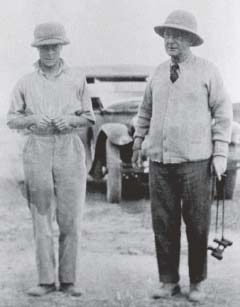
The Prince of Wales and Lord Delamere, 1930.
(Cockie Hoogterp)
Â
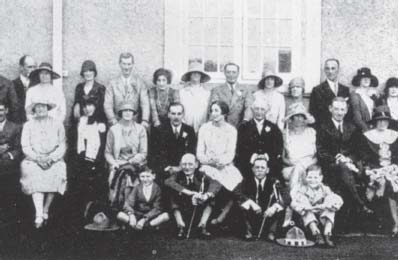
Beryl's second marriage to Mansfield Markham, Nairobi, 1927.
l. to r.
Middle row: Karen Blixen, Clara (Beryl's mother), Mansfield, Beryl, Lord Delamere, unkown. The two boys seated in the foreground are Beryl's stepbrothers.
(British Library)
Â
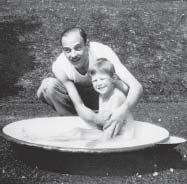
Mansfield and Gervase.
(V. Markham)
Â
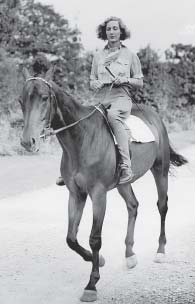
Beryly riding at Aldenham House a few days before her flight. She said it helped her to relax.
(Photosource)
Â

Beryl before presentation at Court, London, 1928.
(V. Markham)
Â
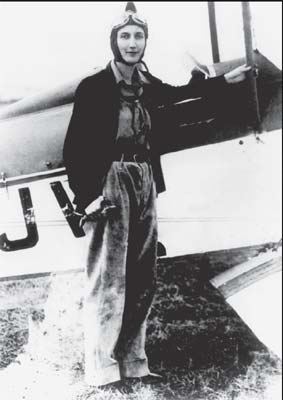
An early picture taken shortly after Beryl learned how to fly in 1931.
(North Point Press)
Â
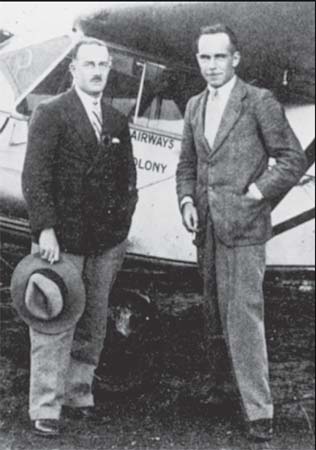
Tom Campbell
(right)
with a passenger for Kenya Airways.
(British Library)
Â
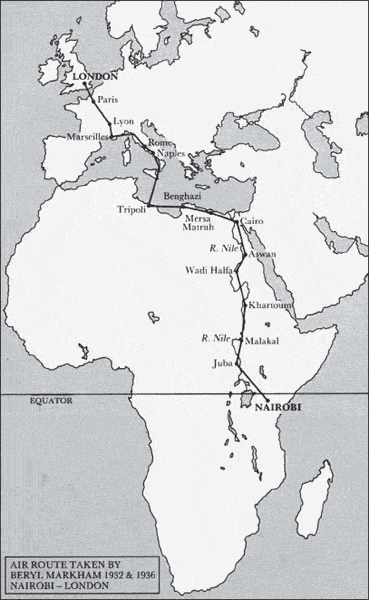
Â
In Florrie Wilson (who later became a pilot of no mean accomplishment), Tom found an enthusiastic backer for a commercial air service in East Africa, and on 31 July, with a capital of £50,000 and a Gipsy Moth aircraft, Wilson Airways was born,
6
with Tom as managing director. Later that year Tom flew the Gipsy Moth, loaded with a seventeen-and-a-half stone passenger (Mr H. White of the Chicago Field Museum) and his baggage, to Croydon in under a week, a sensational time for those days when the journey by sea took up to a month. Whilst in England he purchased an addition to the Wilson fleet â an Avro Five, which he flew back laden with two passengers and an engineer; the Gipsy Moth was piloted by Tommy Woods. In the first full year of operation the company flew more than 150,000 miles at a cost to passengers of one shilling and threepence per mile, and by 1931 â when Beryl was learning to fly â the company had three pilots and a fleet of two Avro Fives, two De Havilland Puss Moths and three De Havilland Gipsy Moths.
7
On the second royal safari, in February 1930, Tom acted as pilot to the Prince of Wales, operating from a hastily cleared bush airstrip near the camp. He flew the prince and his aide Joey Legh across the Rift Valley in a Puss Moth; Legh sat in the fold-away auxiliary seat. Later Tom flew Bror Blixen over Voi to spot elephant â anticipating Denys's idea that this might be a feasible way of locating herds. In March Tom took the prince over Kilimanjaro in a Gipsy Moth. In his diaries the prince recalled:
The view was very wonderful. Below was Lake Amboseli, about it a vast area of swampy shallow pools and dense bush which stretched away eastward to the Tsavo River. Westward was to see, ridge upon ridge, the Great Rift Valley where the Athi goes punctuated always with diamond falls. And forever ahead of [us], rose the huge pile of the Great Mountain, cloud capped Kilimanjaro. And into the blanket of clouds the Moth went too and when it sailed out of them, far below in the sun dazzle, the great domed peak of Kibo glittered in a mail of snow and ice. Glacier after glacier lifted as the Moth soared and circled among the great peaks. It seemed another world after the green tropics.
8
Tom's memories of the time he spent flying the prince are more prosaic. After he flew Blix down to Voi to locate the elephant he took the prince there and when they were over the herd, the prince, who had his rifle with him, shouted to Tom, âGo down, Black, let's have a crack at them.' Tom pretended not to hear and flew on. A little later on the return journey the prince spoke to him and Tom answered. When the prince asked him why he had not landed when they were over the elephants, Tom replied, âI couldn't hear you, sir.' âWell it's damn funny you can hear me now,' the prince retorted.
9
In his early flying days in Kenya Tom had accompanied a safari party into the bush, where, with an early cine-camera, the fearless hunters hoped to get live pictures of a lion kill. One of the men shot a lion and the eager cameraman moved in for his pictures before Tom could warn him to wait. The lion, who was in fact wounded and not dead, attacked the cameraman, and the camera, which was still switched on, recorded the scene. Tom then killed the lion but not in time to save the man. The dead man's wife, who had witnessed the whole thing, was prostrate with shock, and became hysterical when told she could not ship her husband's body back to the United States for burial because they were so far from civilization and because of the heat. Instead Tom and the other members of the party conducted a hasty cremation and placed the ashes in the only available container â a tin biscuit box, an item that Tom never flew without. Tom then flew the widow and the biscuit tin back to Nairobi.
10
In April 1930 Tom made the first non-stop flight from Zanzibar to Nairobi, in five hours and twenty minutes, a journey which normally took two days. It is believed that his was the first aeroplane to land on Zanzibar.
One can imagine the scene at the embryo airport as Tom and Beryl finished their landing run at Nairobi on 11 June 1931. As the Gipsy Moth VP-KAC rolled to a halt amid clouds of red dust, Tom climbed out on to the wing. âWhy don't you take her up now,' he shouted to her, leaning towards the rear cockpit to enable her to hear over the noise of the engine. âJust climb to about eight hundred feet and make one circuit. All right?' Beryl grinned, holding up her thumb in acceptance, and Tom jumped to the ground.
He stood clear and watched as she taxied to the end of the runway and turned into the wind. Then he shaded his eyes, appraising her performance as she started her take-off run. âGood girl, hold her down, hold her down, let her build up speedâ¦' Beryl could hear the words repeated in her head. Wilson airport is over five thousand feet above sea level, a height which significantly affects the performance of light aircraft, particularly in hot weather; a pilot needs to be sure of sufficient speed before pulling back on the stick. Taking to the air without sufficient speed will cause the aircraft to stall and Tom had repeated these words so often in his quiet, confident way that she would never fly again without hearing them in her mind.
11
